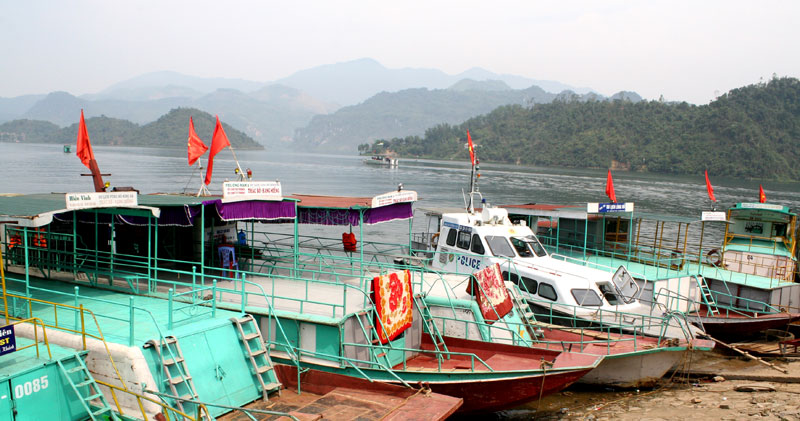
(HBO) – The waterway route on Hoa Binh Lake is 203km long and a national inland waterway route. After the man-made lake was designated as a national tourist site, the number of visitors to the lake has risen remarkably, stimulating waterway transport activities on the lake.
Thung Nai wharf in Cao Phong districts now
serves 169 operating vehicles.
Statistics from the provincial Department of
Transport showed that at the beginning of 2017, Hoa Binh lake recorded 239
passenger vehicles, of which 33 ones carrying both cargo and passengers, 115
have been registered and 124 have not. At present, 38 vessels have valid
registration while those of 77 others have expired. Waterway vehicles
registration has met a lot of difficulties, such as the lack of boat design
before building, as most local vessels were built in the traditional way
without any technical design. As the demand for tourist transportation has
surged in recent years, many households bought cargo ships and converted them
into passenger boats. Some boat owners fail to comply with regulations on
vessel registration due to poor understanding of legal regulations on waterway
transport. The use of substandard vessels for the transport of tourists poses a
high risk of accidents and violates the law.
Recently, the provincial Transport Department
partnered with relevant units to raise public awareness of abiding by legal
regulations on waterway transport safety. It also held dialogues with vessel
groups operating in Thung Nai wharf where there is a large number of vessels
engaging in water transport on Hoa Binh Lake.
The department took note of suggestions made by
vessel owners and proposed solutions to encourage vessel owners to comply with
legal regulations on inland waterway traffic safety. Via communication
activities, heads of vessel groups and boat owners became aware of
responsibility of individuals and organisations, and pledged to urge vessel
owners to promptly complete boat registration as regulated.
About the proposed special mechanism on vehicle
registration on lakes, the department will report it to the Transport Ministry
for consideration. While pending conclusion, vessel owners and register
agencies must seriously abide by the law.
With just over a month left until the school summer break, students are eagerly anticipating a period of rest and fun after a year of academic pressure. To provide a healthy environment for the physical development, in addition to the classes that foster talents and enhance the academic knowledge, sports and physical activities continue to attract a large number of children and teenagers.
On April 17th, Hoa Binh Provincial Museum organized a program to promote and introduce the outstanding values of "Hoa Binh Culture” at the Boarding Secondary and High School for ethnic minority students in Mai Chau District.
The Hoa Binh College of Technical Technology, in collaboration with the Hoa Binh Technical and Economic College and the provincial Association of Literature and Arts, hosted a gathering on April 15 to celebrate Laos’ traditional Bunpimay (New Year) Festival 2025 and debut the new book "Nguoi Muong o ban Don” (Muong people in Don village).
In the millennia-long history of national construction and safeguarding, people of all ethnic groups in Hoa Binh have been united and closely bound together to overcome all difficulties and challenges, standing alongside the entire Vietnamese people throughout the history of building and defending the country.
Living green is a healthy, positive, and sustainable lifestyle that not only helps protect
the environment and quality of life but also conserves natural resources and ecosystems.
Among the many ways to embrace this lifestyle, reducing plastic consumption is one of the most impactful.
The women's unions at all levels in Kim Boi district have been making significant contributions to the movement of building cultural life in the local community.
The movement helps improve rural look and the spiritual and material lives of local residents.



